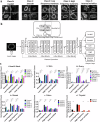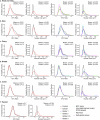Extreme wrinkling of the nuclear lamina is a morphological marker of cancer
- PMID: 39623008
- PMCID: PMC11612457
- DOI: 10.1038/s41698-024-00775-8
Extreme wrinkling of the nuclear lamina is a morphological marker of cancer
Abstract
Nuclear atypia is a hallmark of cancer. A recent model posits that excess surface area, visible as folds/wrinkles in the lamina of a rounded nucleus, allows the nucleus to take on diverse shapes with little mechanical resistance. Whether this model is applicable to normal and cancer nuclei in human tissues is unclear. We image nuclear lamins in patient tissues and find: (a) nuclear laminar wrinkles are present in control and cancer tissue but are obscured in hematoxylin and eosin (H&E) images, (b) nuclei rarely have a smooth lamina, and (c) wrinkled nuclei assume diverse shapes. Deep learning reveals the presence of extreme nuclear laminar wrinkling in cancer tissues, which is confirmed by Fourier analysis. These data support a model in which excess surface area in the nuclear lamina enables nuclear shape diversity in vivo. Extreme laminar wrinkling is a marker of cancer, and imaging the lamina may benefit cancer diagnosis.
© 2024. The Author(s).
Conflict of interest statement
Competing interests: VCS is a consultant and equity holder for Femtovox Inc (unrelated to current work). TCW, CRD, SM, HP, SA, IS, VT, DGR, SC, and TPL declare no competing interests.
Figures





Similar articles
-
Excess surface area of the nuclear lamina enables unhindered cell migration through constrictions.Sci Adv. 2025 Mar 28;11(13):eads6573. doi: 10.1126/sciadv.ads6573. Epub 2025 Mar 28. Sci Adv. 2025. PMID: 40153505 Free PMC article.
-
Nuclear shapes are geometrically determined by the excess surface area of the nuclear lamina.Front Cell Dev Biol. 2023 Jun 15;11:1058727. doi: 10.3389/fcell.2023.1058727. eCollection 2023. Front Cell Dev Biol. 2023. PMID: 37397244 Free PMC article.
-
Clinical Evaluation of a Topical Unani Polyherbal Formulation in the Management of Photodamaged Facial skin: An open-label Standard Controlled Trial.Altern Ther Health Med. 2024 Mar;30(3):16-23. Altern Ther Health Med. 2024. PMID: 38518171 Clinical Trial.
-
Rethinking nuclear shaping: insights from the nuclear drop model.Soft Matter. 2024 Oct 2;20(38):7558-7565. doi: 10.1039/d4sm00683f. Soft Matter. 2024. PMID: 39105242 Free PMC article. Review.
-
The intriguing plant nuclear lamina.Front Plant Sci. 2014 Apr 29;5:166. doi: 10.3389/fpls.2014.00166. eCollection 2014. Front Plant Sci. 2014. PMID: 24808902 Free PMC article. Review.
References
-
- Beale, L. Examination of sputum from a case of cancer of the pharynx and the adjacent parts. Arch. Med2, 1860–1861 (1860).
-
- Krishnamurti, U. G., Fitzgibbons, P. L., Connolly, J. L. Protocol for the Examination of Resection Specimens from Patients with Invasive Carcinoma of the Breast, https://www.cap.org/protocols-and-guidelines/cancer-reporting-tools/canc... (2023).
-
- Fitzgibbons, P. L., Connolly, J. L. Protocol for the Examination of Biopsy Specimens from Patients with Ductal Carcinoma In Situ (DCIS) of the Breasthttps://www.cap.org/protocols-and-guidelines/cancer-reporting-tools/canc... (2021). - PubMed
-
- Mete, O. Protocol for the Examination of Specimens From Patients With Carcinomas of the Thyroid Glan, https://www.cap.org/protocols-and-guidelines/cancer-reporting-tools/canc... (2023).
-
- Seethala, R. R. Protocol for the Examination of Specimens from Patients with Cutaneous Squamous Cell Carcinoma of the Head and Neck, https://www.cap.org/protocols-and-guidelines/cancer-reporting-tools/canc... (2022).
Grants and funding
- I01 CX002776/CX/CSRD VA/United States
- RR200043/Cancer Prevention and Research Institute of Texas (Cancer Prevention Research Institute of Texas)
- 1I01CX002776/U.S. Department of Veterans Affairs (Department of Veterans Affairs)
- U01 CA225566/CA/NCI NIH HHS/United States
- R21 DE032344/DE/NIDCR NIH HHS/United States
LinkOut - more resources
Full Text Sources

